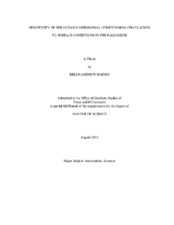| dc.description.abstract | Deep circulations in the ocean affect the distribution of physical, chemical, and biological properties, and are intimately entwined with the planetary-scale climate. Numerous proxies, including neodymium (Nd) in fossil fish teeth, point to a source region in the South Pacific for much of the low-latitude deep-water during the early Paleogene. We use the MIT general circulation model (MITgcm) to test the sensitivity of deep-water formation to uncertainty in surface boundary conditions in a number of numerical modeling experiments with realistic and idealized bathymetries. Finally, the MITgcm is run with a passive tracer, ENd , for some of the experiments mentioned above and to multiple initial surface distributions of ENd.
In our experiments that use idealized basin shapes, appropriate for the early Cenozoic, the formation of North Pacific deep-water occurred in all of our experiments in which we vary the magnitude of the surface density gradient. While the rate of deep-water formation is sensitive to the strength of the surface density gradient, the location of the source regions was not.
For our experiments that use realistic bathymetry, the formation of South Pacific deep-water occurred in a majority of our experiments. Here the Southern Ocean has the greatest poleward latitudinal extent, and therefore preference for deep-water formation. When salinity is added into the equation of state we find that this causes an increase in the extent of Southern Ocean deep-water.
Lastly, we explore simulations using ENd as a passive tracer. Throughout most of the realistic simulations explored, the densest water occurs in the Southern Ocean. There is a strong sensitivity to where in the Southern Ocean the densest water occurs though, either in the South Pacific or Atlantic. With ENd values different in these regions, various simulations produced different tracer distributions. We found this variability in the sinking region to be very sensitive to runoff and seasonality. The sensitivity to the spatial distribution of surface and interior ENd values was found to have little affect on the final ENd distribution, given that the ENd value in the sinking regions was kept constant. | en |


